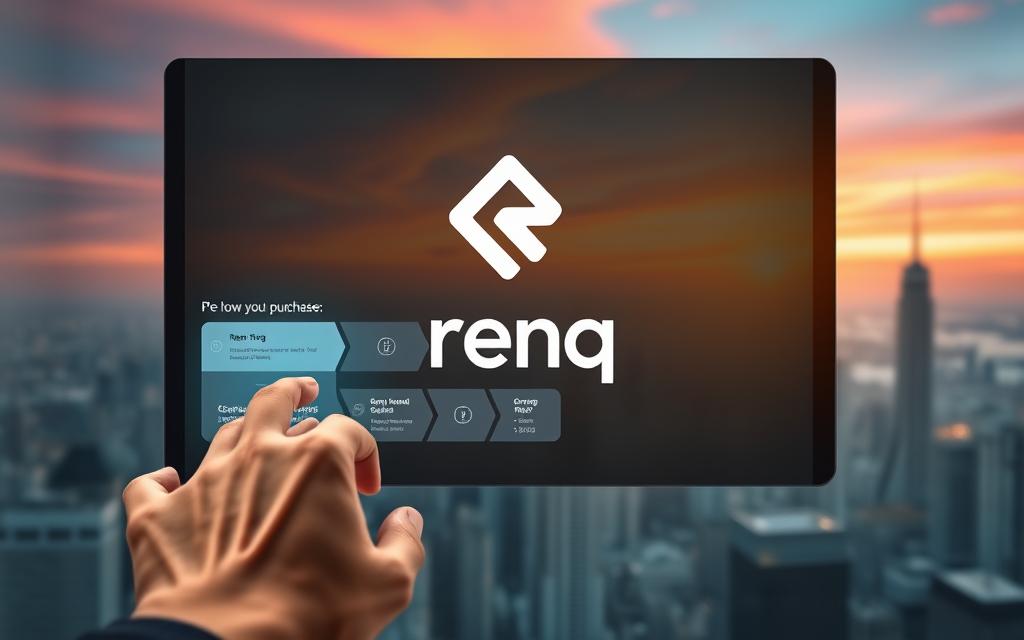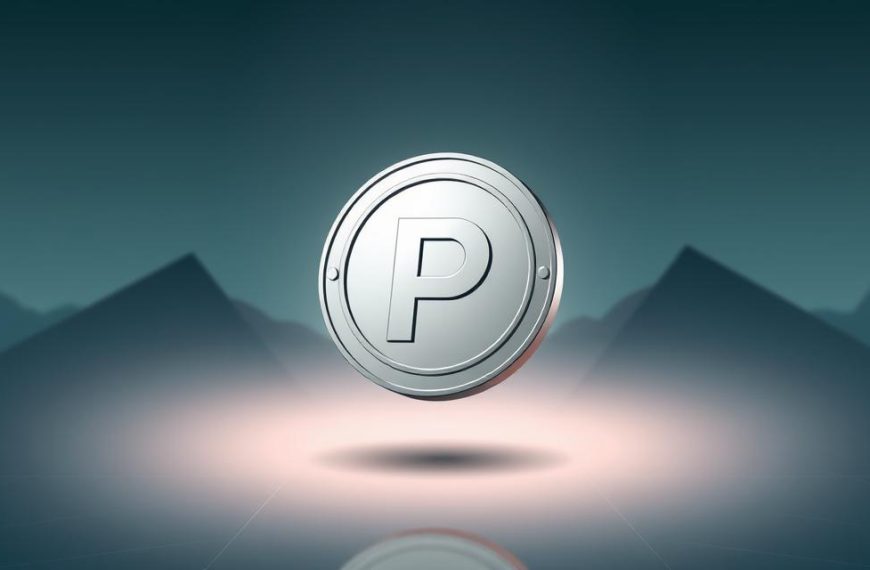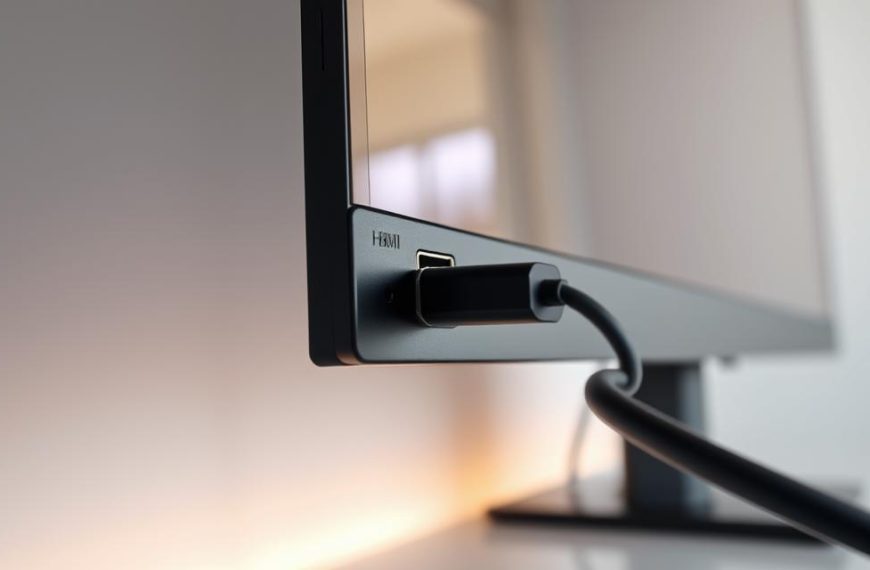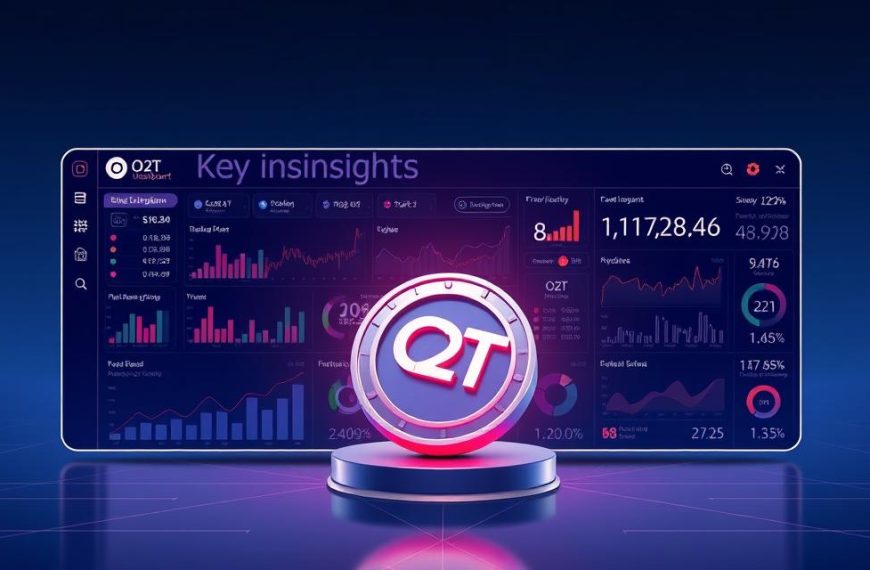This short guide explains the exact steps a beginner needs when approaching RENQ in 2025. It covers centralised platforms, decentralised exchanges and P2P rails, plus safety checks for contracts and on‑chain confirmations.
The journey starts with preparation: set up a wallet, gather ID for verification and choose a trusted platform. Reputable exchanges offer cards, bank transfers and many P2P options to fund purchases quickly.
RenQ Finance is a DeFi platform focused on liquidity, with features such as staking, lending and borrowing. Availability varies by market and region, so your choice of route may change.
Beginners often prefer a centralised exchange for clear pricing and low friction, while advanced users favour DEXs for wallet control and direct token swaps. You will learn the main steps, fee considerations, liquidity checks and secure storage options.
Key takeaways: prepare documentation, compare platforms, watch fees and slippage, confirm contract addresses, and secure tokens after purchase.
What is RenQ Finance (RENQ)?
RenQ Finance is a decentralised finance protocol focused on improving on‑chain liquidity through staking, lending, borrowing and liquidity provision.
The RENQ token is an ERC‑20 asset on the Ethereum network, which means it works with popular Ethereum wallets and DEXs and follows standard smart contract calls.
Core features include community-led integrations, yield opportunities, and utility within the ecosystem. These functions can enable efficient swaps, collateralised borrowing and liquidity rewards for providers.
“Liquidity is the backbone of tradable value on-chain; robust protocols lower slippage and widen access.”
- Compatibility: ERC‑20 tokens sit in wallet addresses controlled by private keys.
- Network impact: Ethereum choice affects gas fees and confirmation times.
- Risk note: demand and perceived value depend on adoption, integrations and market conditions.
| Aspect | What it means | Practical effect |
|---|---|---|
| Token standard | ERC‑20 on Ethereum | Wide wallet and DEX support |
| Liquidity tools | Staking, lending, liquidity supply | Swaps, yield, borrowing options |
| Custody | Private‑key control | Self‑custody recommended for long term |
Practical tip: always check the official contract address before interacting on‑chain and treat roadmap claims with healthy scepticism.
Where you can buy RENQ in 2025: CEX vs DEX vs P2P
Choosing where to acquire RENQ affects fees, speed and custody. Centralised exchanges give a guided experience with fiat on‑ramps, visible order books and support for cards, Apple Pay and bank transfers.
MEXC is presented as beginner‑friendly: cards, local rails, Pre‑Market and Launchpad access plus P2P escrow with verified sellers. Settlement on MEXC P2P typically completes in about 30 minutes once payment is confirmed.
If a CEX does not list RENQ, DEXs such as Uniswap or PancakeSwap are the practical option. These require the correct contract address, wallet approval and payment of gas fees. Liquidity on DEXs depends on pools and can mean higher slippage.
- CEX: easier for newcomers, lower slippage, KYC and fiat rails.
- DEX: self‑custody, direct wallet swaps, gas costs and slippage management.
- P2P: local currency flexibility, escrow protection, useful when mainstream rails are unavailable.
| Route | Speed | Control | Typical costs |
|---|---|---|---|
| Centralised exchange (e.g. MEXC) | Fast settlements, instant trading | Custody by platform unless withdrawn | Trading fees, possible card/fiat fees |
| Decentralised exchange (Uniswap/PancakeSwap) | Fast on‑chain, depends on network | Full self‑custody | Gas fees and pool slippage |
| P2P | Depends on seller and payment method (~30 mins typical) | User retains control after settlement | No platform trading fee; payment provider fees may apply |
Match your skill level and risk tolerance with the right option. Verify contract addresses, enable 2FA on exchanges, and confirm seller reputations on P2P before trading.
Before you start: wallet, KYC, networks and funding
Start by securing a Web3 wallet, confirming networks and preparing ID for exchange verification. This reduces delays when you fund an account or move funds on‑chain.
Choosing and setting up a Web3 wallet
Select a reputable wallet such as MetaMask or Trust Wallet, and consider a hardware option like Ledger or Trezor for higher security.
Step by step: install the app or browser extension, generate the seed phrase and record it offline. Enable a strong device passcode and never share your seed.
Completing KYC and preparing funds
MEXC and many exchanges require KYC to unlock fiat rails. Complete verification with current ID to avoid funding delays.
Fund via USDT, USDC or USDE using card, bank transfer, OTC or P2P. Test transfers with a small amount, confirm addresses and watch network fees and confirmation times.
- Tip: some users fund a self‑custody wallet and use a DEX; others deposit fiat to a CEX and trade on spot.
- Security: enable 2FA and anti‑phishing, and store offline backups for private keys.
Buying RENQ on a centralised exchange (CEX) like MEXC
For many users, an exchange platform like MEXC reduces friction when acquiring tokens via fiat or stablecoins.
Create and verify your account
Sign up with an email and set a strong password. Complete identity verification to unlock card and bank rails and raise deposit limits.
Tip: keep KYC documents handy for faster approval.
Deposit or buy USDT/USDC via card, bank transfer or Apple Pay
Add funds using Visa/Mastercard, SEPA or SWIFT, Apple Pay where available, or P2P escrow and local rails (PIX, PayNow, GCash).
Choose USDT, USDC or USDE as the trading base and confirm the network and fees before sending funds.
Navigating to Spot trading and searching the RENQ trading pair
Open the Spot section, search the market for the renq trading pair and view the order book, depth and recent trades.
Assess liquidity by scanning bid/ask spreads and recent volume before placing an order.
Placing market versus limit orders and completing the purchase
Market orders execute instantly; use them when liquidity is ample and speed matters.
Limit orders give price control and help during volatile listing periods. Consider laddered limits to reduce price impact.
Before confirming the transaction, review fees, verify sufficient balance and check the post‑trade balance in your exchange wallet.
Payment methods and pre-market/launchpad options
MEXC offers Pre‑Market access with protected settlement after listing, Launchpad allocations via MX or USDT stake, and Airdrop+ tasks for rewards.
Security controls: enable 2FA, set withdrawal whitelists and use anti‑phishing codes to protect your account.
| Step | Action | Practical note |
|---|---|---|
| 1 | Register & KYC | Unlock cards, bank rails and higher limits |
| 2 | Deposit USDT/USDC | Use card, bank transfer, P2P or local rails; confirm network |
| 3 | Go to Spot | Search trading pair; check order book and depth |
| 4 | Place order | Market for speed; limit for price control |
| 5 | Confirm & review | Check fees, wallet balance and downloadable statements |
For a guided walkthrough on MEXC steps, see this purchase guide for platform specifics and links to Pre‑Market and Launchpad pages.
Buying RENQ on a decentralised exchange (DEX)
Decentralised swaps demand careful checks before you connect a wallet or sign a trade.
Confirm the exact token address. Only use the official contract address from RenQ Finance channels or verified explorers. A wrong address can mean counterfeit tokens or a permanent loss.
Funding and gas estimation
Fund your wallet with the base asset for the chosen network, for example ETH on Ethereum or BNB on BSC. Keep extra for network fees so the transaction can confirm.
Estimate gas via your wallet prompt or a block explorer before sending funds.
Connecting and slippage
Connect MetaMask or another wallet to Uniswap, PancakeSwap or DEX+ depending on your network.
If RENQ is not listed, import the verified contract address. Set slippage tight for deep pools and widen slightly for low liquidity.
Approval, swap and verification
Approve the token spend if required, then execute the swap. Wait for on‑chain confirmation and copy the transaction hash.
Verify the hash on Etherscan or BscScan, confirm token balances and add a custom token entry if it does not display automatically.
Troubleshooting and liquidity tips
- Failed swap? Try higher gas, modestly higher slippage, or split the order into smaller trades.
- Low liquidity causes price impact; split buys across multiple swaps or wait for deeper pools.
- Safety: review site permissions, disconnect after use and avoid signing unknown prompts.
| Step | Action | Practical note |
|---|---|---|
| 1 | Verify contract address | Source from official RenQ Finance channels or verified explorer |
| 2 | Fund wallet | Include extra for gas and network fees |
| 3 | Connect DEX | Use Uniswap, PancakeSwap or DEX+ based on network |
| 4 | Approve & swap | Approve spend, execute swap, then wait for confirmation |
| 5 | Verify | Check transaction hash on a block explorer and confirm balances |
Practical step: keep a transaction log, back up wallet settings, and consider a dedicated wallet for DEX activity to compartmentalise risk.
Using P2P to acquire RENQ-friendly crypto and convert
Peer-to-peer marketplaces let local buyers source stablecoins from verified sellers using native payment rails. MEXC P2P supports many local methods and holds the seller’s token in escrow until payment confirmation, which lowers counterparty risk and speeds settlement.
Selecting verified sellers and secure escrow flow
Filter sellers by completion rate, limits and clear terms. Use in-platform chat for clarifications and never move off-platform for messaging or payments.
Escrow matters: the platform releases USDT only after the seller confirms receipt of funds, so keep payment proofs ready for disputes.
Converting P2P purchases via Spot or DEX
Once USDT arrives, options include trading on Spot if RENQ is listed or withdrawing to a self-custody wallet and swapping on a DEX with the verified contract address.
| Step | Action | Note |
|---|---|---|
| 1 | Create account & complete KYC | Unlock payment rails and dispute protection |
| 2 | Select currency & pick seller | Prefer high completion rates and clear limits |
| 3 | Pay within platform window | Keep proof and never mark paid before sending funds |
| 4 | Receive USDT & convert | Use Spot for listed tokens or withdraw for DEX swap |
Be aware of spreads, withdrawal and trading fees. Settlement often completes within ~30 minutes after payment confirmation but may vary by bank rails.
Start with a small test trade, keep transfers on the correct network and address, and consider referrals from friends for limits or discounts — but always prioritise platform safeguards over private arrangements.
how to buy renq crypto — a quick step‑by‑step recap
Keep this short action plan at hand while you choose between exchange, wallet and P2P rails.
- Decide your route. Choose a CEX for simplicity, a DEX for self‑custody or P2P for local payment flexibility.
- Set up security. Create a secure wallet and back up the seed phrase if you plan self‑custody. Complete KYC on a chosen exchange for fiat access.
- Fund the account or wallet. Use card, bank transfer or P2P to get USDT/USDC on a CEX, or acquire ETH/BNB for DEX gas and swaps.
- Execute the trade. On a CEX, go to Spot, find the RENQ pair and place a market or limit order. On a DEX, connect your wallet, confirm the contract address, approve and swap.
- Verify completion. Check balances on the platform and confirm transactions via a block explorer. Add the token to your wallet view if needed.
- Store safely. Keep small balances on exchanges with 2FA for convenience; withdraw larger holdings to a hardware wallet for long‑term security.
- Track costs. Note trading fees, spreads, gas and slippage. Consider laddered entries or DCA to reduce execution risk.
- Keep records. Save order IDs, transaction hashes and receipts for reconciliation and tax reporting.
- Revisit your plan. Set alerts and review liquidity and market depth before adding or exiting a position.
- Stay vigilant. Watch for fake contracts, phishing pages and unsolicited messages; always cross‑check addresses and platform URLs.
Practical note: follow your chosen route, but treat verification and token address checks as mandatory steps regardless of method.
| Step | Action | Where | Key check |
|---|---|---|---|
| 1 | Choose route | CEX / DEX / P2P | Match skill and fees |
| 2 | Prepare access | Wallet & KYC | Seed backup & verified ID |
| 3 | Fund | Card, bank, P2P or wallet | Correct network and small test |
| 4 | Trade & confirm | Spot or DEX swap | Contract address and tx hash |
Costs, liquidity and slippage: fees to expect when buying RENQ
Trading costs and liquidity levels shape execution quality and the effective renq finance price you receive.
CEX costs. Centralised platforms like MEXC advertise low fees and deep liquidity across 2,800+ tokens. Expect maker/taker fees, card or bank funding charges and rare spreads during volatile listings.
DEX costs. Decentralised swaps add gas for approvals and swaps. Slippage and price impact rise when pool depth is shallow, so larger orders can move the market and raise the final price.
P2P economics. Peer listings show visible spreads between buyer and seller. Payment rails may add fees and you may then convert received USDT on a venue with its own costs.
- Use limit orders on a CEX during active market hours to control execution.
- Split DEX orders across several swaps to reduce price impact.
- Compare quotes across venues and include all fees in the final calculation.
| Route | Primary costs | Liquidity effect |
|---|---|---|
| Centralised exchange | Maker/taker, funding fees, possible spreads | Usually deeper; better execution |
| Decentralised exchange | Gas, slippage, approval fees | Depends on pool depth; higher impact for large orders |
| P2P | Visible spread, payment provider fees | Wallet withdrawal or conversion may affect final price |
Final checks: always review the renq finance price and fee schedules before confirming a transaction. Using USDT as a base often simplifies quoting, but verify the all‑in price including slippage and network delays.
How to store your RENQ safely after purchase
Deciding where to hold assets after settlement defines your control and risk profile. For many users, leaving tokens on an exchange wallet offers speed and convenience for trading.
Keeping RENQ on an exchange wallet: convenience and 2FA
Exchange wallets like MEXC provide rapid access, 2FA, encryption and withdrawal whitelisting. These platforms also use cold storage for large holdings, which lowers platform counterparty risk.
Use case: short-term traders or users who need instant market access benefit from exchange custody.
Withdrawing to self-custody: software versus hardware wallets
Software wallets such as MetaMask or Trust Wallet give easy access and dApp compatibility for routine swaps and staking.
Hardware devices like Ledger and Trezor store private keys offline. Set a PIN, record the seed phrase on paper or metal, and manage ERC‑20 tokens via the official companion app.
Best practices: seed phrases, phishing protection and backups
Never share your seed phrases. Avoid plain-text storage and keep multiple secure backups in separate locations.
Verify platform URLs, bookmark official pages, enable anti‑phishing codes and be wary of unsolicited messages posing as support.
- Regularly review token approvals and revoke unnecessary permissions on dApps.
- Use a dedicated device or browser profile for wallet activity and keep software up to date.
- Teach close friends or recovery contacts the right steps without revealing secrets.
- Perform periodic audits: check balances on a block explorer and test recovery on a spare device.
How to sell or convert RENQ when you’re ready
Knowing which venue and order type to choose will shape your realised price and fees. On centralised platforms such as MEXC you can use Spot trading for a quick exit or finer control.
Spot selling and limit orders
Place a market order for immediate fills when liquidity is ample. This is useful during fast moves or when speed is your priority.
Use a limit order to target a specific price and avoid market impact. Consider laddered limit sells across several price points to balance execution and target returns.
Converting into stablecoins and quick swaps
Convert RENQ into USDT or another stablecoin to lock in proceeds and simplify withdrawals. MEXC supports direct conversion and spot sells into USDT.
Converter tools provide one‑click swaps at quoted rates with near‑instant execution and zero slippage — handy when time matters more than micro price improvement.
P2P off‑ramps, withdrawals and records
P2P lets you list stablecoins, select verified buyers and receive local currency via escrowed payment rails. Always use platform escrow to lower counterparty risk.
Before withdrawing confirm the destination network and test a small transfer. Account for platform fees, limits and any pre‑market or launchpad lock‑ups that may restrict immediate sales.
| Action | Practical note | Why it matters |
|---|---|---|
| Market sell | Fast, uses available liquidity | Immediate exit |
| Limit sell | Price control, can be laddered | Better average price |
| Convert via tool | Quoted rate, near zero slippage | Speed and certainty |
| P2P off‑ramp | Escrowed local fiat receipts | Withdraw in local currency |
Track realised P&L, fees and timestamps using exportable trade histories. Experienced traders often hedge or stage exits across sessions, and use alerts for price thresholds and liquidity signals to avoid rushed selling during volatility.
Conclusion
, Finalise your plan with clear steps and strong security practices.
Choose a listed exchange such as MEXC for on‑ramps and tools like Pre‑Market, Launchpad and Airdrop+. Bitrue highlights DEX paths and wallet hygiene. BTCC reminds users that RENQ began with presale mechanics and remains DeFi‑centric.
There are three core options: CEX, DEX and P2P. Match each option with your risk tolerance, payment access and tooling preference. Use DCA, trend confirmation or laddered orders for disciplined entries.
Confirm contract addresses, enable 2FA, back up seeds and compare quotes and fees before you purchase renq. Start small, log transactions and refine your approach as experience grows.
Action prompt: verify token details, pick your route, fund with USDT or base assets, then proceed step by step towards owning renq tokens with confidence.



















